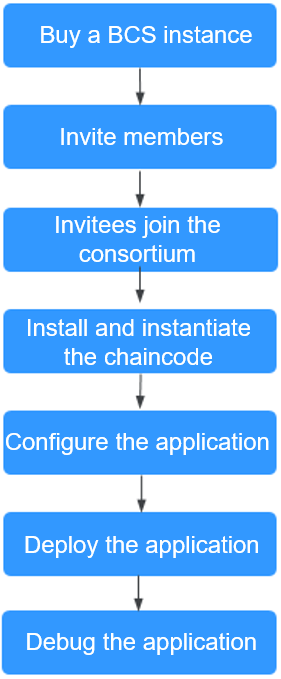Overview
Background
With the continuous advancements of IT, interbank business processes become standardized. However, some operations are redundant. For example, it takes a long time and tedious procedure to query users' basic information such as account and identity across banks, resulting in poor user experience.
Solution
Blockchain Service (BCS) provides consortium blockchains based on enhanced Hyperledger Fabric. After creating a consortium blockchain, you can invite other banks to join it. Consortium members can share data with each other in a trusted manner, which saves time for users and improves the efficiency for banks. Peers of each consortium member run in a separate VPC for independent and secure management.
This best practice uses a bank consortium blockchain as an example to explain the basics of consortium blockchains and how to form a consortium blockchain. It helps you quickly get started with Huawei Cloud BCS.

This is a demo only and is not for actual use.
Scenario
- Business scenario and members:
- democraticBank invites civilizationBank and harmoniousBank (invitees A and B) to join the bank consortium.
- A customer registers accounts with civilizationBank and harmoniousBank without Know Your Customer (KYC) checks based on an existing account and KYC check results of democraticBank.
- Requirements
Data such as user identities must be encrypted to protect the information against brute force attack. Quick information queries based on identities must be supported.
- Key challenges:
- Security and privacy: Banks require no disclosure of customer privacy information to other banks.
- High-performance retrieval: Retrieval performance (millisecond-level response) similar to that of legacy databases must be delivered to ensure user experience.
- Easy-to-use interfaces: Simple and convenient interfaces must be provided to facilitate application development.
Process Flow
The following describes the general process of setting up a consortium blockchain.

- Buy a BCS instance.
Buy a consortium blockchain and name the organization member democraticBank.
- Invite tenants to join the consortium.
After the consortium blockchain is created, organization member democraticBank invites civilizationBank and harmoniousBank to join the consortium blockchain.
- Invitees join the consortium.
civilizationBank and harmoniousBank join the consortium blockchain based on the invitation information.
- Install and instantiate the chaincode.
The chaincode must be installed by the inviting party and all invitees (in this demo, invitees A and B), and can be instantiated by any member in the consortium.
- Configure the application.
Before initiating transactions, the inviting party must download the administrator certificates of the orderer and organization democraticBank, and the certificates of invitees A and B with the private keys hidden.
- Deploy the application.
Install the bank consortium blockchain demo application on an Elastic Cloud Server (ECS).
- Debug the application.
After the application is deployed, you can test data transactions on the consortium blockchain.
Feedback
Was this page helpful?
Provide feedbackThank you very much for your feedback. We will continue working to improve the documentation.See the reply and handling status in My Cloud VOC.
For any further questions, feel free to contact us through the chatbot.
Chatbot





